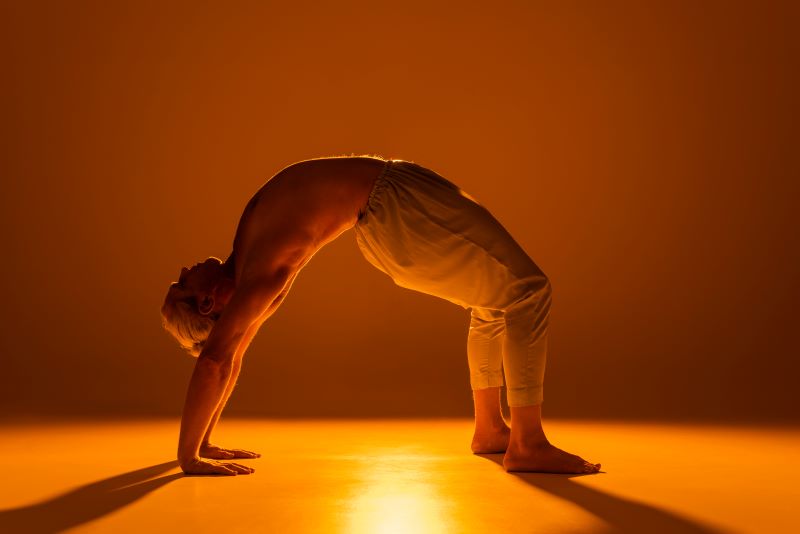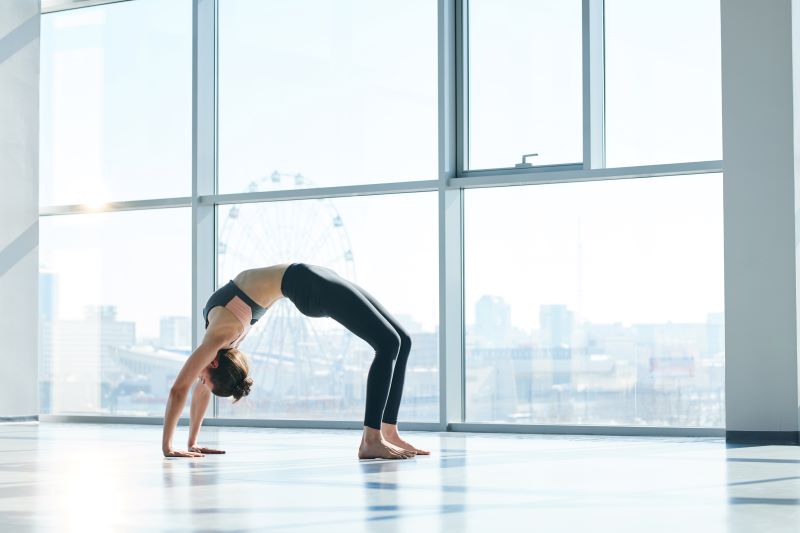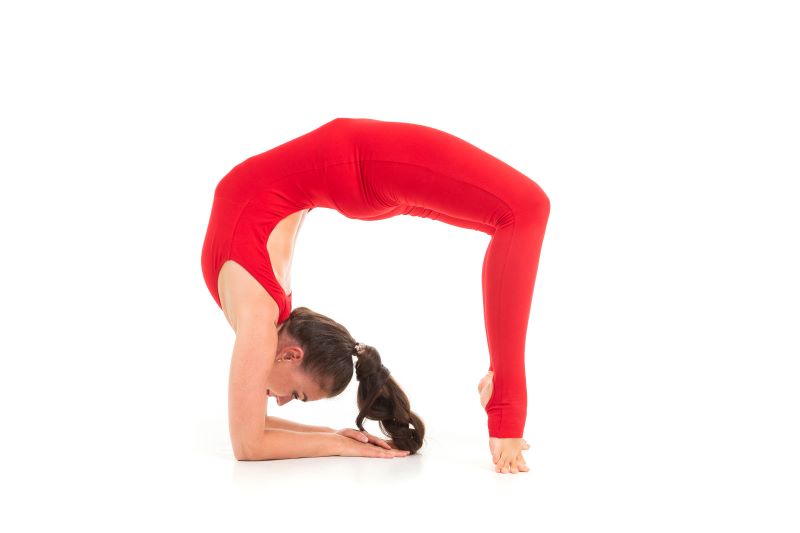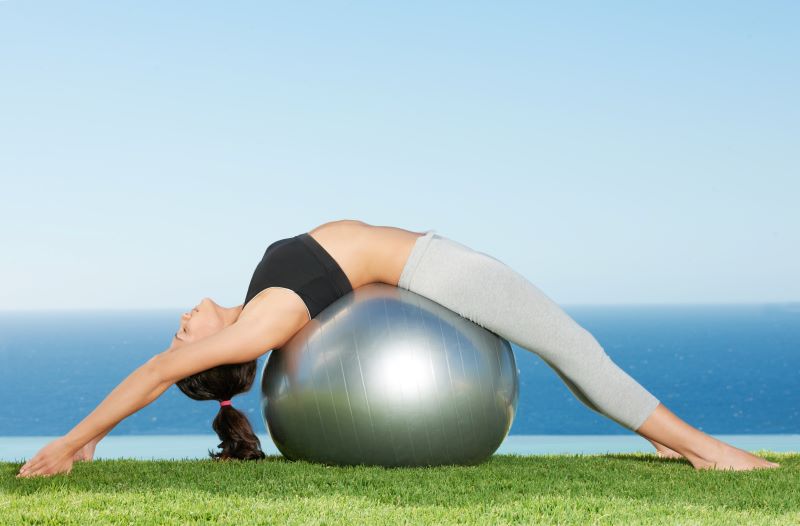15 Health Benefits of Chakrasana & How to Do It?

Yoga has numerous health benefits for people of all ages. It improves strength, balance and flexibility. People who practise yoga experience an increase in their energy levels and alertness and a decrease in negative feelings. Good management of stress and promotion of better self-care are some more advantages.
Often, the first thing that comes to mind when someone says yoga is Chakrasana. It is a flexible exercise with lots of advantages. Read the following sections to learn about the benefits of Chakrasana.

Table of Contents

What is Chakrasana (Wheel Pose)?
Chakrasana, also called Wheel Pose, is a strong back-bending yoga asana. It is a Sanskrit word. The word ‘chakra’ denotes a wheel, while ‘asana’ means pose. You need to bend your body backwards like a wheel when practising this asana, so another name for it is Wheel Pose.
Chakrasana is also called Urdhya Dhanurasana. When seasoned yoga practitioners perform this pose, their bodies resemble a rainbow.
How to Perform Chakrasana?

Now, it is time to take a look at the Chakrasana procedure.
A step-by-step guide is provided below explaining how to perform this asana:
Step 1: Lie on the ground. Place your feet hip-width apart. Then, raise your knees. Your feet should be flat on the floor.
Step 2: Lift your arms overhead and bend your elbows. Place your palms on the floor beside your ears, ensuring your fingers point forward.
Step 3: As you inhale, exert pressure on your palms and legs. Gradually, lift the entire body up to form an arch.
Step 4: Drop your head gently behind. Make sure that your neck is relaxed.
Step 5: Ensure your body weight is evenly distributed between the four limbs.
Step 6: Stay in that position and focus on your breathing. Gradually lower your back to the ground. Do not lose focus from breathing evenly.
Step 7: Lie down on your back. Remain in that position briefly before moving on to the next asana.
15 Health Benefits of Chakrasana
Chakrasana, also known as Wheel Pose, is a backbend in yoga that offers numerous health benefits. Here are some key advantages:
1. Improvement of Blood Circulation
Chakrasana makes the heart pump faster, which improves blood circulation in the body. This reduces the risk of cardiac problems and relieves any stress. It also leads to better immunity, which further improves health.
2. Spine Flexibility and Strength
Chakrasana significantly strengthens and improves the elasticity of the spine. It builds stamina and strength. The human skeletal frame starts shrinking as we age. Asanas like the Wheel Pose help maintain our form and posture.
3. Tones the Abdomen
The benefits of Chakrasana include toning of the core muscles and reduction of fat in the abdomen. Moreover, it reduces the risk of diseases linked to chronic obesity, like diabetes, kidney problems and cardiac problems.
4. Addresses Respiratory Disorders
People who suffer from respiratory problems can try Chakrasana. It expands the lungs and improves the intake of oxygen. Additionally, this asana is beneficial for asthmatic people.
5. Stimulates the Endocrine and Nervous System
Practising Chakrasana stimulates the pituitary glands and thyroid. It leads to the secretion of dopamine, the happy hormone. As a result, it gives people more energy and reduces stress and tension in the body.
6. Beneficial for Diabetics
Chakrasana results in a deep stretch that improves different body functions. It has been shown to reduce blood glucose levels, which is helpful for patients with type 2 diabetes.
7. Beneficial for Thyroid Disorders
Practising Chakrasana is beneficial for people who suffer from thyroid disorders as well. This is because regular back-bending stimulates the cells in the endocrine system.
8. Improvement of Overall Internal and External Wellbeing
Chakrasana ensures both physical and mental improvement. It works on all the muscles in your body, which strengthens them. It also helps with metabolism and posture and can be used for weight loss. Regular practising of the Wheel Pose provides clarity of thought and mental peace.
9. Enhances Digestive Health
Chakrasana helps improve digestion by stimulating the abdominal organs. This asana promotes the efficient functioning of the digestive system, reducing issues such as constipation and bloating. Practising this pose regularly can lead to a healthier gut.
10. Boosts Energy Levels
Engaging in Chakrasana revitalises the body and mind, leading to an increase in energy levels. This boost in energy can enhance productivity and reduce feelings of fatigue. It is particularly beneficial for those who experience low energy during the day.
11. Improves Mental Focus and Concentration
Chakrasana helps to enhance mental clarity and focus. The increased blood flow to the brain during this pose can improve concentration and cognitive functions. This mental benefit makes it an excellent practice for students and professionals alike.
12. Reduces Anxiety and Depression
The Wheel Pose is effective in alleviating symptoms of anxiety and depression. By stimulating the endocrine system and increasing the release of endorphins, Chakrasana promotes a sense of well-being and emotional stability. Regular practice can lead to a more balanced mental state.
13. Strengthens the Back and Glutes
Chakrasana is particularly beneficial for strengthening the muscles of the back and glutes. This asana helps develop a strong and toned posterior chain, essential for overall body stability and posture.
14. Enhances Heart Health
By improving cardiovascular endurance and promoting efficient blood flow, Chakrasana supports heart health. This asana helps maintain a healthy heart rate and reduces the risk of heart disease. Regular practice contributes to long-term cardiovascular well-being.
15. Promotes Better Sleep
Chakrasana can improve sleep quality by reducing stress and calming the mind. The relaxation and mental peace achieved through this asana can lead to deeper and more restful sleep. Practising this pose in the evening can help alleviate insomnia and other sleep disorders.
Other Benefits:
It improves the strength of the arms, shoulders and wrists.
Practising Chakrasana is also suitable for patients who have osteoporosis and infertility.
Additionally, it helps in removing dullness from the mind.
Types of Chakrasana
Chakrasana, or Wheel Pose, can be practised in various forms, each offering unique benefits and challenges. Here are the main types of Chakrasana:
1. Wheel Pose (Chakrasana)

The classic Wheel Pose is the foundational version of this asana. It involves a deep backbend where the body forms an arch resembling a wheel. This pose enhances spinal flexibility, strengthens the arms and legs, and boosts overall energy levels.
2. One-Legged Wheel Pose (Eka Pada Chakrasana)

In this pose, practitioners lift one leg while holding the Wheel Pose. This variation increases the challenge by requiring greater balance and strength. It significantly strengthens the core, improves balance, and enhances the flexibility of the hip flexors and hamstrings.
3. Forearm Wheel Pose (Dwi Pada Viparita Dandasana)

This pose, also known as Dwi Pada Viparita Dandasana, is an advanced variation where the practitioner supports their body on the forearms instead of the hands. This pose demands increased shoulders and upper back flexibility and substantial strength in the core and lower body. It deepens the backbend and enhances the flexibility and strength of the upper body.
Things to Know Before Doing Chakrasana Yoga
Chakrasana is a powerful yoga asana that requires preparation and mindfulness. Understanding the necessary precautions and preparatory steps is crucial to perform this pose safely and effectively.
- Warm-Up is Essential: Ensure a thorough warm-up to prepare your body for the deep backbend. Incorporate poses like Bhujangasana and Setu Bandhasana to increase flexibility.
- Practice Under Guidance: If you are a beginner, perform Chakrasana under the supervision of a qualified yoga instructor to avoid injuries and ensure proper alignment.
- Avoid Heavy Meals: Avoid heavy meals for at least three hours before practising Chakrasana. An empty stomach is ideal for yoga practice.
- Check Health Conditions: Consult with a healthcare provider if you have any medical conditions such as back pain, wrist injuries, or cardiovascular issues. Certain conditions may require modifications or complete avoidance of the pose.
- Stay Hydrated: Maintain adequate hydration before practising to support muscle function and prevent cramps.
How Long to Hold Chakrasana Pose?
The duration for holding Chakrasana, or Wheel Pose, varies based on your experience and comfort level. Here's a guide for different practitioners:
- For Beginners: Beginners should start by holding Chakrasana for 5 to 10 seconds. Focus on maintaining proper form and breathing steadily. Gradually increase the duration as you build strength and flexibility.
- For Intermediate Practitioners: Intermediate practitioners can aim to hold the pose for 15 to 30 seconds. The body is more accustomed to the backbend at this stage, allowing for a more extended hold that enhances endurance and deeper muscle engagement.
- For Advanced Practitioners: Advanced practitioners can hold Chakrasana for 1 to 2 minutes or longer. With enhanced strength, flexibility, and control, longer holds can deepen the stretch and benefit the spine and overall body strength.
Risks of Overdoing Chakrasana
While Chakrasana offers numerous benefits, overdoing this pose can lead to several risks and injuries. Here are some potential risks to be aware of:
- Spinal Injuries: Excessive practice can strain the spine, leading to discomfort, misalignment, or severe injuries such as slipped discs or spinal fractures.
- Wrist and Shoulder Strain: Prolonged weight-bearing on the wrists and shoulders can cause tendonitis, carpal tunnel syndrome, or other overuse injuries.
- Lower Back Pain: Overstretching the lower back muscles and ligaments can result in chronic pain or acute injuries, affecting mobility and comfort.
- Neck Injuries: Incorrect alignment or overexertion can strain the neck muscles, leading to stiffness, pain, or more severe issues like cervical spine injuries.
- Overstretched Ligaments: Pushing beyond your flexibility limits can overstretch ligaments, reducing joint stability and increasing the risk of dislocations.
- Breathing Difficulties: Holding the pose for too long may cause shortness of breath or hyperventilation, mainly if the chest and diaphragm are excessively compressed.
Important Tips for Practising Chakrasana
While Chakrasana is beneficial, beginners might find it difficult to perform it. Here are some tips for Chakrasana for beginners that will make it easier to perform:
1. Perform Chakrasana After a Proper Warm-up
Before performing Chakrasana, prepare your body by doing a few cycles of Surya Namaskar at the beginning. Then proceed to Bhujangasana and Urdhva Mukha Shvanasana. You can also try Setu Bandha Sarvangasana before proceeding to do Chakrasana.
2. Hold the Posture
When performing the asanas mentioned above to prepare the body, hold the poses for a minimum of 15-30 seconds. This will ensure your back is thoroughly ready to perform this deep back bending. Furthermore, this will reduce the risks of any injury.
3. Proper Supervision Is Essential
If you are a beginner, then the best idea would be to perform this asana under the supervision of a yoga instructor. This will reduce the chances of getting hurt.
4. Do Not Overstretch
It is not a good idea to overstretch your body while performing Chakrasana.
5. Consult a Medical Practitioner if Necessary
If you are suffering from any particular medical condition, consult your doctor before performing deep backbends like Chakrasana. Moreover, if you experience discomfort, talk to your instructor and, if necessary, to your doctor.
What are the Precautions and Contraindications of Chakrasana?
It is essential to keep in mind the following precautions and contraindications to avoid an accident while performing Chakrasana:
Wear comfortable clothes while performing Chakrasana. Light and comfortable cotton clothes are ideal, as they facilitate easy body movements.
Do not consume heavy meals for at least 3 hours before performing this asana. Generally, yoga experts recommend practising asanas on an empty stomach.
Before doing this deep back-bending asana, you must prepare your body through subtle exercises and asanas.
Perform Chakrasana slowly, and beware of your breathing.
Make sure you are well-hydrated before performing yoga.
The yoga mat upon which you perform Chakrasana must have a good grip.
Additionally, if you are suffering from tendonitis of the wrists or carpal tunnel syndrome, you should not practise this yoga asana.
You should not perform Chakrasana if you suffer from elbow pain, vertigo, a slipped disc, diarrhoea, or hernia.
Make sure the room where you are practising Chakrasana is well-ventilated.
People suffering from spinal injuries or back pain should avoid performing Chakrasana as it might cause stress.
If anyone has weak wrists, there are better ideas than performing Chakrasana. This asana requires the practitioner to exert pressure on the wrists, which can cause injuries.
Who Should Avoid Doing Chakrasana?
Chakrasana is a powerful backbend that may not be suitable for everyone. Specific individuals should avoid practising this asana to prevent injuries and health complications.
- People with Spinal Injuries: Individuals with existing spinal conditions, such as herniated discs or chronic back pain, should avoid Chakrasana to prevent exacerbating their condition.
- Individuals with Wrist or Shoulder Issues: Those suffering from carpal tunnel syndrome, tendonitis, or shoulder injuries may find the weight-bearing nature of this pose too strenuous.
- Pregnant Women: Women, especially in the later stages of pregnancy, should avoid this deep backbend as it can put undue stress on the abdomen and lower back.
- Heart Patients: Individuals with cardiovascular issues, such as heart disease or high blood pressure, should refrain from performing Chakrasana due to the increased demand for the heart.
- People with Glaucoma or Eye Pressure Issues: This pose can increase intraocular pressure, making it unsuitable for those with glaucoma or other eye pressure-related problems.
- Individuals with Recent Surgeries: Those who have recently undergone surgeries, especially involving the spine, wrists, or abdomen, should avoid this pose until fully healed and cleared by a healthcare provider.
What are the Easy Modifications of Chakrasana?

You can incorporate the following methods to perform this yoga asana with ease.
- Wall Support: You can use the wall to support your shoulders and arms. Stand approximately 3 feet away from the wall with your chest closed and arms on the wall. This will help you gain confidence in performing Chakrasana.
- Use a Gym Ball: To easily get into this posture, keep a gym ball on the floor. However, ensure that the floor is rough to avoid injuries from slippage.
- Place Block Below Your Palms: Try this pose by keeping a block of blankets below your palms for support. This will prevent injury to your neck and shoulders.
- Use a Stool: Another way to support your back correctly is to keep a height stool. You can also use cushions on the stool to ensure your entire back gets rest.
- Seek Help: Beginners can seek help from instructors, friends, or any family member to support them in going up. However, ensure your feet and palms are well-rooted to avoid injuries.
To sum up, it is time to get on your yoga mat to get the benefits of Chakrasana. This asana, also called Wheel Pose, helps to strengthen muscles, improves blood circulation and has other benefits. However, maintaining consistency in practising is necessary. Furthermore, the tips and precautions mentioned above are also essential.













